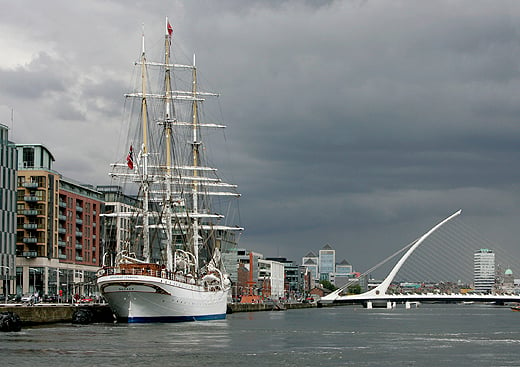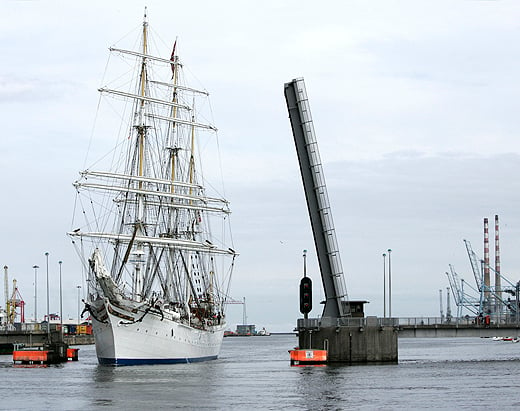Displaying items by tag: Samuel Beckett Bridge
Dublin City Council Owned Tallship 'Jeanie' Faces Further Delays Until Authority Reopens Swing-Bridge
#JeanieDelayed - Once again delays to relocate tallship Jeanie Johnston to her normal home-berth closer to Dublin’s city-centre on the Liffey’s northside continue to beset the popular visitor tourist attraction, writes Jehan Ashmore.
As previously reported on Afloat, the delays are due to ongoing maintenance work with the iconic Samuel Beckett swing-bridge. The bridge commissioned by Dublin City Council was opened in 2009.
The works have so far prevented the replica 19th century famine-emigrant museum tallship Jeanie Johnston (ownership of DCC) in finally reaching the Custom House Quay. The tallship was originally scheduled to return to this quay this weekend. Until last month the tallship had been drydocked which in itself was a historic event.
Dublin City Council commented to Afloat to say that the ongoing maintenance works on the Samuel Beckett Bridge are due to take place next week on the Monday and Tuesday. During this work it is planned to open the bridge to permit the Jeanie Johnston to proceed up the Liffey to her customary berth. This will merely involve a short hop across the Liffey to the more conducive Custom House Quay given its proximity to the city-centre.
In the meantime the replica museum barque remains berthed further downriver along Sir John Rogersons Quay on the south quays. Guided tours however are running and will remain so up until next Tuesday. Unlike the Custom House Quay’s pontoon berth, tours of the tallship at this current south quay berth are restricted to tidal conditions and given that boarding involves a gangway.
According to Sea-Cruise Connemara, which operate the tallship on behalf of DCC, tour tickets are on sale at Custom House Quay. This is some five minute walk away.
The tourist attraction explores the Jeanie Johnston’s tragic role during the famine which forced thousands of destitute people to emigrate to North America. In all 16 voyages were taken by the tallship between 1847 and 1855 and notably transporting over 2,500 people with no loss of life.
The previous owners of Jeanie Johnston were the Dublin Docklands Development Authority (DDDA) which acquired the vessel in 2005. After more than a decade the Dublin Docklands Development Authority Dissolution Act resulted in the assets of the DDDA (including the replica barque) transferred to Dublin City Council.
As for the Samuel Beckett Bridge, the striking structure was designed by the internationally renowned architect and engineer, Dr. Santiago Calatrava. The structure arrived by barge from where it was constructed in the Netherlands. Its distinctive harp-like appearance has made the bridge an attraction in its own right as it elegantly spans the Liffey lined with glazed buildings from the heady heights of the Celtic Tiger era. The buildings house finance, accountancy and law firms in addition residential appartments.
A revival in construction in this financial quarter has emerged in recent years notably with even higher rise newbuilds than the Celtic Tiger. The current construction underway is part of DCC’s Strategic Development Zone (SDZ). Afloat as previously reported on Dublin's 'London' Landings Docklands in which more will be explored about the relationships of other new buildings and ships that call to the inner old port.
The revival of this new-found confidence along this stretch of the Liffey presents an ever changing skyline. Equally as in the case of the shipping scene with vessels arriving and departing. Among them the odd visiting cruiseship bringing economic activity through tourism.
Sistership of Figaro Race ‘Guardship’ to Visit
#NAVAL VISIT – A sistership of the French Naval patrol vessel that performed 'guardship' duties during last year's La Solitaire du Figaro Race to Dun Laoghaire (click HERE), is due to dock in Dublin Port in advance of St. Patrick's weekend, writes Jehan Ashmore.
PSP Pluvier (P678) is a 54m offshore patrol vessel (OPV) that belongs to a trio of the'Flamant' class, the remaining pair are the leadship PSP Flamant (P676) and PSP Cormoran (P677). The latter OPV escorted the race fleet on the second leg between Ouistreham (Caen) to Dun Laoghaire, the only international port of call of the prestigious race.
The naval visitor is the last of the sisters built and was constructed in Cherbourg at Chantier des Constructions Mécaniques de Normandie (CMN). She entered service in 1997 and carries out patrols in seas up to 200 nautical miles offshore of the French économique exclusive zone (ZEE).
She is scheduled to arrive on Thursday afternoon and berth at Sir John Rogersons Quay, downriver from the Samuel Beckett swing-bridge.
Norwegian Tallship Opens to the Public in Dublin Docklands
The arrival of the largest and oldest Norwegian tallship the barque S/S Statsraad Lehmkuhl into Dublin Port yesterday made for an impressive sight, even without her sails set, writes Jehan Ashmore.



Her arrival marks nearly a year in advance to Dublin City welcoming the return of the Tall Ships Races, presented by Szczecin and organised by Sail Training International. The capital last hosted the event in 1998 and next year up to 100 tall ships are to sail into the capital which will be the final host port for four days between 23rd-26th August 2012.

Tall Ship S/S Statsraad Lehmkuh in Dublin Bay yesterday. Images: Iain White
The celebration of sail is expected to draw entrants from as far away as Chile, Mexico, Argentina, USA and European and Baltic countries including Italy and Norway will chart their course to Dublin. It is hoped that the event will attract over a million visitors to the city, topping the 500,000 spectators who thronged the Waterford quays during this year's tall ship race gathering.

Photo: Jehan Ashmore
Small Is Beautiful as Cruiseships Call Closer to Capital
Clipper Odyssey is an unusual caller to the capital as she normally operates cruises in the Pacific Ocean from New Zealand to the Russian Far-East. As for Le Diamant she is a frequent caller not just to Dublin but throughout Irish ports during the season.
The Bahama-flagged 110-passenger Clipper Odyssey is scheduled to depart this evening around 21.45hrs. She is bound for Dunmore East with an lunchtime arrival off the Waterford fishing port. Le Diamant with a capacity for up to 226 passengers follows with a departure set for 23.00hrs and she is bound for Fishguard Harbour, the gateway to the scenic Pembrokeshire Coast National Park.
Currently only small cruiseships can dock within the 'Docklands' quarter quays due to the limitations imposed on dimensions, as vessels transit through the East-Link toll lift-bridge which was built in 1984. The majority of cruiseships, which are considerably larger and can exceed over 100,000 gross tonnes, berth 2kms downriver mostly in Alexandra Basin and adjoining Ocean Pier.
There are proposals to build a dedicated cruise-terminal close to the East-Link bridge on the far side at North Wall Quay Extension, which would allow such larger vessels to dock. This would facilitate easier access for cruise tourists to visit the attractions of the city-centre and indeed the nearby amenities of the O2 Arena, which would be within walking distance of the proposed cruise terminal.
- Dublin Port
- Dublin Docklands
- Sir John Rogerson's Quay
- Cruise Liners
- Cruiseships
- Sean O'Casey Bridge
- River Liffey
- Cruise Liner news
- Samuel Beckett Bridge
- Cruisecallers
- Le Diamant cruiseship
- Clipper Odyssey cruiseship
- Dublin GasWorks
- Dublin Gasometer
- Ringsend Gasworks
- Pembrokeshire Coast National Park
- O2 Arena
Dundalk Dredger Docked in Dublin Port Is Up for Sale
The Dublin Port Company has sought expressions from interested parties in undertaking the remaining activities of the port on an exclusive basis.
The Dundalk registered dredger arrived to the capital port on 14 July where she remains berthed at the Bulk Jetty in Alexandra Basin. Her previous owners, the Dundalk Port Company were unique in that they were the only port company to own and operate a dredger in the Republic. For many years the 757-tonnes dredger has carried out numerous contract assignments in ports throughout the island of Ireland including work on the Samuel Beckett swing-bridge and the most project was at Queens Quay, Belfast on the Lagan close to the city-centre.
Hebble Sand was launched by Richard (Shipbuilders) of Lowestoft for British Dredging and later used by Associated British Ports to serve a network of UK ports. Despite her age, the near fifty-year-old veteran vessel has been kept in excellent condition and this was evident during a rather unusual appearance for a ship of her type when attending the Dublin Docklands Maritime Festival in 2009.
She was made open for the public amongst the tall-ships that lined the Liffey Quays. Such an initiative was inspiring as it provided a rare opportunity for the public to access such a dredger which otherwise is not familiar compared to the popularity of visiting tall-ships and naval vessels.
The only other port to operate their own dredger is Londonderry Harbour Commissioners, whose Lough Foyle has worked on projects outside her homeport. This has included work at the new £40m Stena Line ferryport terminal on Loch Ryan close to Cairnryan and is due to open in November.
- Dublin Port
- Dublin Port Company
- Dundalk Port Company
- Stena Line
- Port of Dublin
- Ports and Shipping News
- Alexandra Basin
- Ferry news
- Dundalk Port
- Samuel Beckett Bridge
- Dredger Hebble Sand
- Dredger Lough Foyle
- Londonderry Harbour Commissioners
- Samuel Beckett SwingBridge
- Cairnryan ferryport
- Loch Ryan ferry terminal
- Associated British Ports
- ABP
- Richards Shipyard
- Queens Quay Belfast
- Dublin Docklands Maritime Festival 2009
Summer Festival in the Heart of Dublin’s ‘Docklands’
The Docklands Summer Festival takes place this weekend in Dublin's 'Docklands' and it is to host the Waterways Ireland Inter-County Sailing Championship, writes Jehan Ashmore.
Other events taking place on the River Liffey and throughout the docklands range from a Dragon Boat display in the Grand Canal Dock (outer basin) and a Boat Show (inner basin) see map. In addition the Waterways Ireland Visitor Centre will be open, noting all these activities and venues are to take place between 10am-6pm on Saturday.
On the following Sunday the Waterways Ireland Inter-County Sailing Championship Races are scheduled between 10am-4pm in the Grand Canal Dock's outer basin. City Canal Cruises will operate each day as well as an International Food Market, held in the Grand Canal Square, opposite the Grand Canal Theatre.
The pristinely kept M.V. Cill Airne, now a floating restaurant and bar will be open at her berth alongside North Wall Quay, close to the striking Samuel Beckett Bridge and The Convention Centre.
The historic veteran vessel built in Dublin at the Liffey Shipyard in the early 1960's was launched as a passenger tender to serve trans-Atlantic liners that called to Cobh. During her tender-duties she brought the rich and famous ashore to include Laurel & Hardy and US President Eisenhower.
The festival is sponsored by Waterways Ireland and the Docklands Business Forum. To see the full festival programme and a map of the docklands click HERE and www.ddda.ie
- Waterways Ireland
- Cobh
- DDDA
- Dublin Bay News
- Port of Dublin
- River Liffey
- Grand Canal Dock
- Docklands Summer Festival
- Dublin Docklands Development Authority
- Samuel Beckett Bridge
- The Convention Centre
- North Wall Quay
- City Canal Cruises
- Grand Canal Theatre
- M.V.Cill Airne
- Passenger Tender
- TransAtlantic Liners
- Laurel & Hardy
- President Eisenhower
- US President Eisenhower
- Dublin City
- Docklands Business Forum
- Dragon Boat Display
- Dragon's
- Dragon sailing boats
- Dragon craft




























































